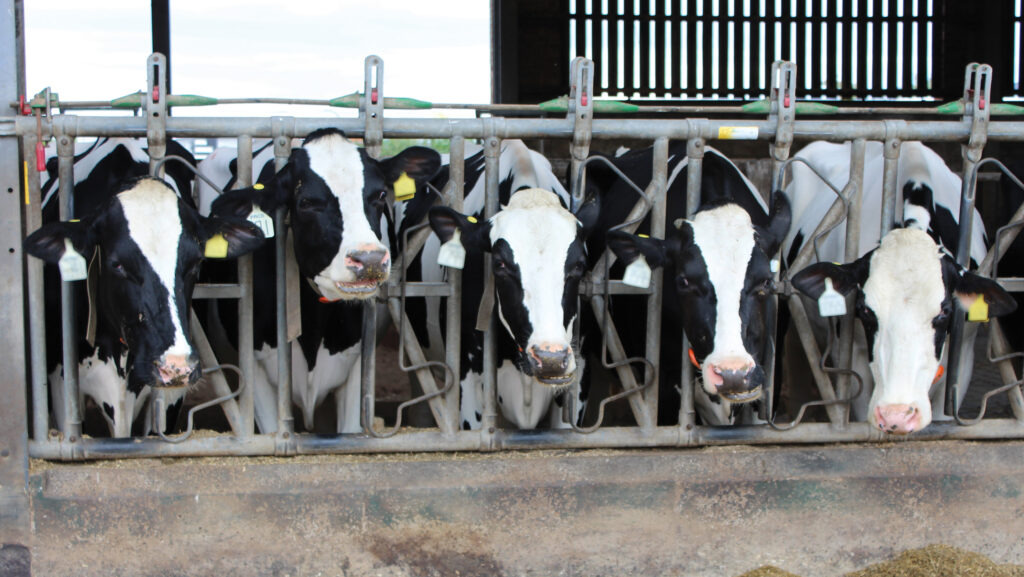How a 2,600-cow housed herd drove down carbon emissions
 © Aly Balsom
© Aly Balsom Integration of dairy and arable enterprises, targeted use of nutrients and a focus on feed sourcing have been the driving forces behind a 40% drop in emissions at Grosvenor Farms, Cheshire, over the past decade.
The 2,340ha (5,782-acre) business has focused on producing more from less and achieving lasting commercial, social and environmental benefits, while hitting high levels of animal welfare in the herd of 2,600 housed dairy cows, according to managing director Mark Roach.
See also: How carbon audit kick-started dairy’s net-zero ambition
Such an approach has resulted in the herd having one of the lowest carbon emissions within the Tesco Sustainable Dairy Group (TSDG) milk pool, at 939g carbon dioxide equivalent (CO2e)/litre.
This compares with an average across the 323 farms in the TSDG milk pool of 1,158g CO2e/litre of milk.
Farm facts: Grosvenor Farms, Aldford, Cheshire
- 2,600 dairy cows supplying Muller Tesco
- Housed all year
- 12,324 litres a cow a year at 3.8% protein and 4.54% fat
- 1,000kg milk solids a cow a year
- 0.47kg/litre feed rate
- 2,000 youngstock, calving at 23 months
- 900ha combinable crops, 350ha maize, 900ha grassland, 300ha in stewardship/biodiversity
- Heat recapture, solar PV, planning permission received for anaerobic digester producing 60,000MWh hours of green gas annually
With ambitions to become net zero within six years, the farm team looked at the following areas.
Targeted nutrient use
Investing in sand and slurry separation and methods of application to make the best use of farm nutrients has been a “real win” in driving down the emissions intensity across the business.
It has led to a marked reduction in bought-in fertiliser use and boosted soil organic matter. This, together with min-till practices, has benefited soil carbon storage.
Dairy manager David Craven explained that 85% of the forages fed to cows were grown purely using nutrients from manure.
Arable manager Charlie Steer added that the aim was to have as little loss in the system as possible:
“We haven’t bought any mined P [phosphorus] and K [potassium] for 15 years, and we’re applying our nutrients using low emissions technologies, be it injection [or] dribble bar.
“We’re putting it on at the right time, the right place, the right amount, across a whole host of crops.”
Growing cover crops on maize
A cover crop of forage rye was direct-drilled after maize to avoid the environmental risks associated with leaving ground bare over winter.
Charlie said the aim was to grow an early maturing maize crop that could be harvested at the end of September, with the cover crop established in the first week of October using home-grown seed.
This would be cut in April, providing a useful feed for the herd. The winter cover also helped boost soil organic matter and preventing nutrient leaching.
Feed sourcing and forage quality
To lower the carbon footprint of the diet, soya has been excluded for the past six years and by-products with low emission values fed, such as bread and Trafford Gold, when effective to do so.
David said the decision to feed by-products was largely driven by economics and would vary year-to-year depending on whether it was more cost effective to feed home-grown cereals.
Maximising the quality of home-grown forage was also a key driver.
Three-and-a-half-year perennial ryegrass and red clover leys were cut on a multicut system and consistently analysed at 11.5-12MJ/kg metabolisable energy (ME) and 16-17% crude protein.
“That’s offsetting purchased feed and helping us drive yield,” he explained.
Breeding for feed conversion efficiency
For the past two years, feed conversion rate (FCR) had been included in selection criteria, alongside fertility, longevity, litres and kilos of fat.
Selecting for FCR using the EcoFeed index should or will help drive efficiencies and lower the herd’s footprint by producing more from less.
Speaking at one of the event’s talk stations, Cogent genetics specialist Sion Parry explained: “We want cows with good residual feed intake, so they eat less at a given body weight and level of production.”
The first batch of heifers selected with FCR in mind have just entered the herd.
The animals with the lowest FCR averaged 1.47 litres of energy corrected milk (ECM)/kg dry matter (DM), while the elite averaged 1.59 litres ECM/kg DM.
Sion said: “If we move the average animal to where the elite are now, that would be circa £150 greater margin over all feed per cow per year.”
A feed supplement to reduce methane emissions
The recent inclusion of a methane inhibitor in the diet is predicted to deliver a 31% reduction in enteric methane emissions at Grosvenor.
The Bovaer feed additive was included in the farm’s mineral and fed at 1.5g a cow a day.
The reduction in methane output should equate to about 1.3t carbon dioxide a cow a year, or 3,417t CO2e/year, said independent consultant Adrian Packington.
Regenerative agriculture applicable to all systems
The principles of regenerative agriculture are applicable to all dairy systems, and the whole industry needed to recognise that “we’re all on the same side”, according to Grosvenor’s arable manager, Charlie Steer.
Speaking to Farmers Weekly, Charlie said regenerative principles, such as maintaining soil cover and integrating livestock, did not specify whether cows were housed, and there needed to be less “finger pointing” within the industry.
At Grosvenor Farms, the 2,600-cow herd is housed all year round and produces more than 12,000 litres a cow a year.
Charlie added: “We believe, and we have data to show, our system increases soil carbon, biodiversity and water quality. All the outcomes of regenerative agriculture, we’re achieving, but our cows don’t go outside.”
